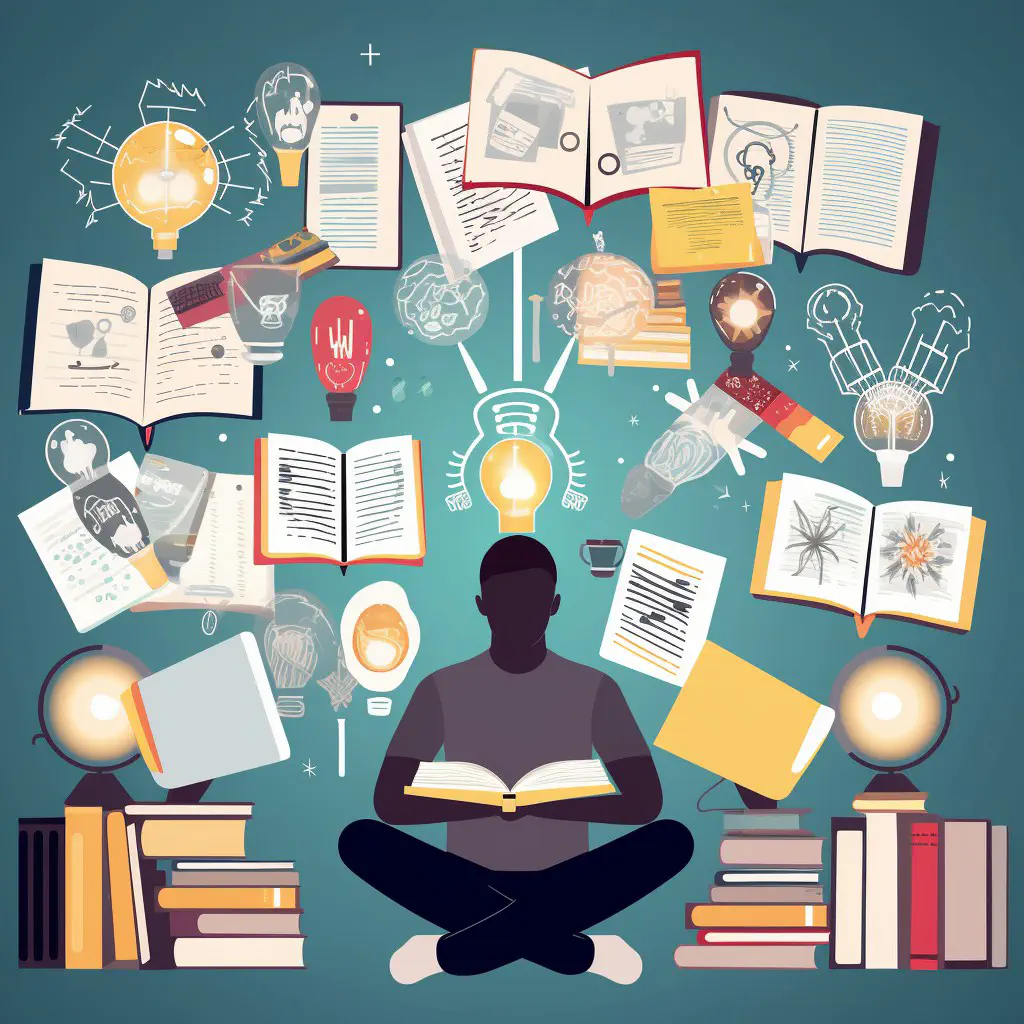
Introduction
Welcome to Revolutionary Techniques for Accelerated Learning! This guide is designed to help you learn and retain information faster than ever before.
Accelerated learning is becoming increasingly important in today’s fast-paced world. With so much information at our fingertips, it’s crucial that we are able to filter and understand the material quickly and efficiently.
In this guide, we’ll explore five methods that have been proven to help accelerate learning. Whether you’re a student, professional, or lifelong learner, these techniques can be applied to any subject and level of learning.
So let’s dive in and discover how you can learn smarter, not harder!
Method 1: Spaced Repetition
Spaced repetition is a technique that involves scheduling learning material reviews at specific intervals in time. It is based on the scientific principle that information is more easily retained if it is encountered repeatedly at intervals.
Definition of spaced repetition
Spaced repetition is a learning technique that involves reviewing material at increasingly large intervals to promote long-term memory recall. This method is particularly effective for memorizing facts and vocabulary.
How to implement it in everyday learning
To implement spaced repetition in everyday learning, you can use tools like flashcards or an app. The basic idea is to review material at regular intervals, starting with short intervals and gradually increasing the time between reviews. For example, you might review a set of flashcards immediately, then again in 1 hour, then 6 hours, 1 day, 2 days, and so on.
Examples of using spaced repetition
Spaced repetition can be used in a variety of contexts. For instance, you can use it to learn a new language by reviewing vocabulary words with increasing intervals. Similarly, you can use it to memorize historical dates or mathematical formulas. Spaced repetition is particularly useful when you have a large amount of material to learn and want to retain it for a long time.
Method 2: Mind Mapping
Mind mapping is a technique that helps learners visually connect and organize their thoughts and ideas. A mind map is a type of diagram that uses branches to represent different topics and subtopics, allowing learners to see the relationship between them. The main topic is usually placed at the center of the diagram, with subtopics branching out from it.
Benefits of using mind maps
- Mind maps are great for brainstorming and organizing ideas.
- They help learners to see the relationships between different topics, making it easier to remember and understand concepts.
- Mind maps are also effective in linking prior knowledge with new information.
How to create a mind map for accelerated learning
Creating a mind map is quite easy. Here’s a simple process learners can use to create their own mind maps for effective learning.
- Start by positioning the main topic or subject in the center of the paper.
- Next, branch out from the center by drawing a line and writing a subtopic or concept.
- Continue to create sub-branches from each subtopic, with related ideas and information branching out from each subtopic.
- Use different colors and images to represent each subtopic and make the mind map visually appealing.
Tips for using mind maps for accelerated learning
- Use short, concise notes to make it easier to understand and remember information.
- Use colors and images to make the mind map more visually appealing and memorable.
- Review the mind map regularly to reinforce memory retention.
- Use mind maps for summarizing and reviewing information after learning new concepts.
Overall, mind mapping is an effective strategy for learners seeking to accelerate their learning abilities. By visually connecting their thoughts and ideas, mind maps help learners organize their knowledge and improve their retention of new information.
Method 3: Active Recall
Active recall is a technique used in learning to retrieve information from memory based on previously learned material. According to research, active recall improves long-term retention and leads to better learning outcomes. This technique helps learners to retain information and recall it more easily when it is needed in practical situations.
Definition of active recall
Active recall is a method of retrieving previously learned information from memory without relying on external cues or support. It is a retrieval practice that enhances long-term retention of knowledge and increases the ability to apply that knowledge in real-life situations. Most learners use active recall to improve their study habits as it helps in reinforcing memory retention and creating pathways that make it easier to recall information in the future.
How to use it effectively
To use active recall effectively, learners must first retrieve previously learned information before learning new material. This process strengthens the neural pathways in the brain and makes it easier to recall information in the future. One method is to create flashcards with questions on one side and answers on the other. Learners can then use these flashcards to test their recall ability and to reinforce their learning.
Another way to use active recall is by taking practice quizzes or tests. By answering questions on previously learned material, learners can practice retrieving information and reinforce their memories. While taking practice quizzes, learners must avoid the temptation of looking at notes or other resources as this defeats the purpose of active recall. It is essential to practice with enough frequency, spacing the practice over several days to make the retention stronger.
Studies that support the benefits of active recall
Many studies have shown that active recall benefits long-term memory retention and recall. A study conducted by Roediger III and Karpicke found that active recall facilitated long-term retention of information among college students. Another study conducted by McDaniel et al. reported that using active recall led to better retrieval performance than passive reading of study materials.
In conclusion, active recall is an effective technique for improving long-term memory retention and recall. Learners must practice the technique regularly to reinforce their learning and create neural pathways that help them retrieve information more easily. By incorporating active recall into their learning strategies, learners can increase their chances of success and achieve better learning outcomes.
Method 4: Visual Learning
Visual learning is a powerful tool for accelerated learning that involves using visual aids to enhance memory and understanding. This technique can be applied in many subjects and learning contexts, from language learning to scientific concepts.
Explanation of visual learning
Visual learning is the process of acquiring new information through visual aids such as diagrams, charts, graphs, or videos. This learning method is often used to express complex ideas or information in a simple and easy-to-understand way. Visual aids can help learners retain more information, recall it more easily and stimulate creativity.
Techniques to enhance visual learning
There are many techniques and strategies to enhance visual learning, such as:
-
Using images in learning materials: Including images in learning materials can help learners to better connect with the subject. Images can be used as metaphors, cues, or shorthand that help you recall important concepts.
-
Visual note-taking: A form of note-taking that involves the use of symbols, diagrams, and drawings to record information in a way that makes it more memorable. This technique is particularly useful for retaining information in lectures, conferences, and meetings.
-
Mind Maps: Mind maps are a visual tool for organizing thoughts, ideas, and information. This concept is used to create an elaborate visual hierarchy of the content, that helps learners to identify interconnection and relationships among ideas.
-
Flashcards: A popular technique that involves using visual cues to help recall information. This technique is widely used for learning vocabulary, formulas, or facts. Create flashcards with visual elements for a better outcome.
Examples of materials that can be used for visual learning
Some materials that can be used for visual learning are:
-
Videos on Youtube or other sources: Search for video resources that explain concepts visually. This is especially useful when learning how to do something or when working with visual information like maps or diagrams.
-
Diagrams and Illustrations in books or study materials: Look for books or study materials that use lots of diagrams, charts, or drawings to illustrate concepts.
-
Interactive Whiteboards: Whiteboards are an excellent technology to organize visual concepts and work with interactive activities.
-
Flashcards apps: Use flashcards apps to study and memorize vocabulary, formulas, and facts.
Conclusion
Visual learning is an effective and powerful technique that can be used to accelerate learning in different contexts. It helps learners to organize information and reinforce memory. By using a variety of visual aids, learners can enhance their understanding and recall of information, leading to improved learning outcomes.
Method 5: Time Management
Effective time management is crucial to accelerating your learning and achieving success. Here are some strategies that you can use to manage your time and maximize your productivity:
Create a Schedule
Creating a schedule is an essential part of time management. By having a set schedule, you can ensure that you are allocating enough time to your studies while also managing your other responsibilities. Make a list of all the tasks that you need to complete, including study time, work, and personal commitments. Assign each task a specific time slot, and be sure to include breaks in your schedule to avoid burnout.
Prioritize Your Tasks
Prioritizing your tasks is the key to managing your time effectively. To determine which tasks are the most important, ask yourself what tasks will move you closer to your goals. Once you have identified your top-priority tasks, focus on completing them first.
Manage Distractions
Distractions can make it difficult to stay focused on your studies. Identify the things that distract you the most and work to eliminate them from your study environment. If you find that social media is a distraction, consider using an app or program that blocks social media sites during your study time. If noise is a problem, invest in noise-cancelling headphones or find a quiet study space.
Create a Productive Environment
Creating a productive study environment can help you stay focused on your tasks and achieve your goals. Make sure that your study space is comfortable and free from distractions. Keep your study materials organized and easily accessible. Consider investing in a comfortable chair and desk to help you maintain good posture and avoid discomfort while studying.
Take Breaks
Taking regular breaks is an important part of time management. Too much studying can lead to burnout, which can make it difficult to retain information. To avoid burnout, take a 10-15 minute break every hour. Use this time to move your body, stretch, or take a quick walk outside.
By implementing these time management strategies, you can maximize your productivity and accelerate your learning. Remember that what works for one person may not work for everyone. Experiment with different techniques until you find the ones that work best for you.
Conclusion
In conclusion, we have discussed five revolutionary techniques for accelerated learning. These methods are spaced repetition, mind mapping, active recall, visual learning, and time management. By implementing these techniques, learners can improve their focus, retention, and recall abilities, ultimately leading to more successful learning experiences.
We encourage readers to try these techniques and find the methods that work best for their learning style. It is essential to be patient and consistent in the use of these techniques, as they require time and effort to implement effectively.
In today’s fast-paced world, accelerated learning is becoming increasingly important. By investing in these methods, we can gain a competitive edge and remain relevant in our chosen fields. By taking control of our learning experience, we can achieve our goals and aspirations more efficiently.
In conclusion, let us all strive to embrace these revolutionary techniques for accelerated learning and continue to enhance our knowledge and skills. With the right mindset and approach, we can achieve great things and reach our full potential as learners and professionals.

